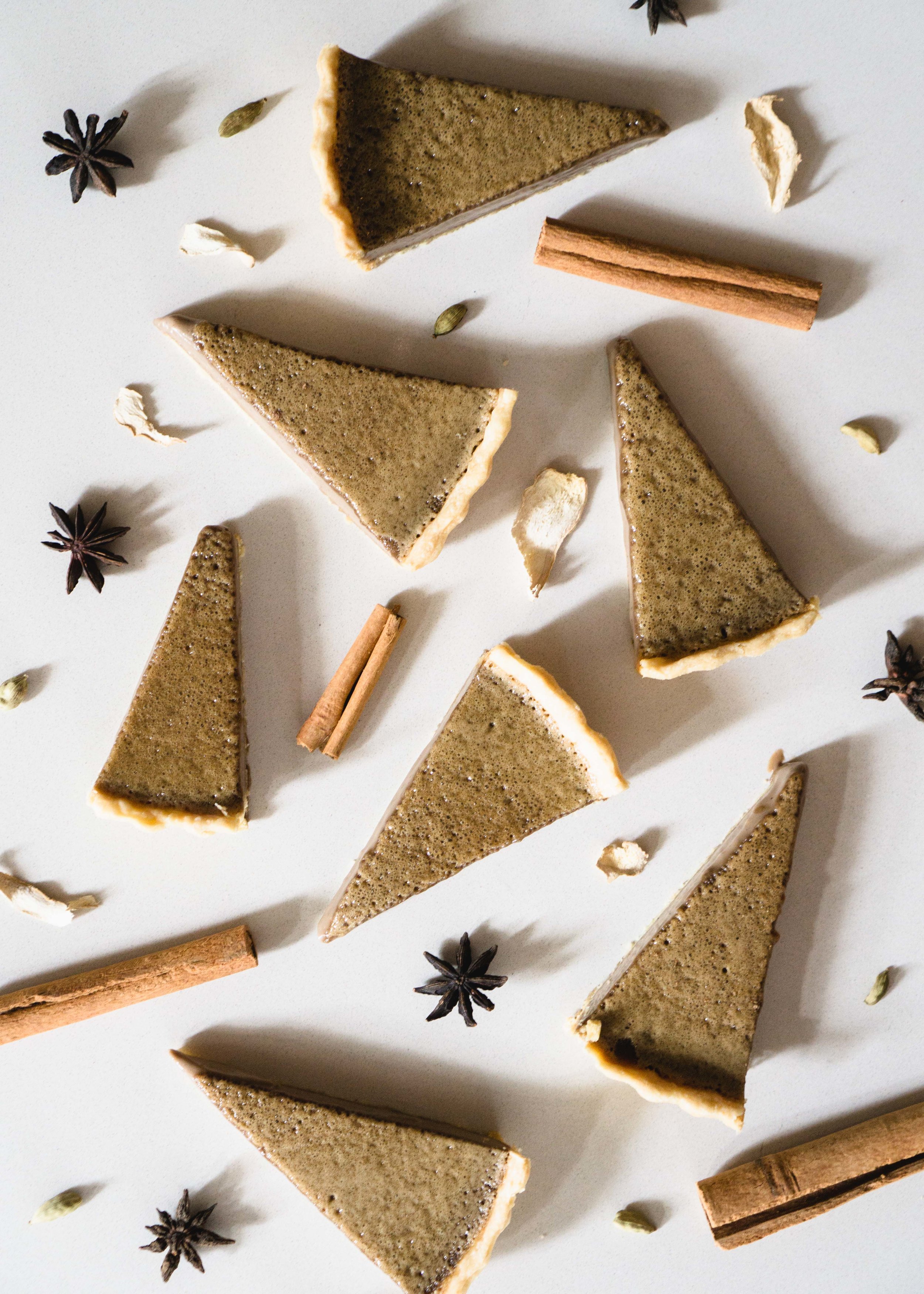Masala Chai Custard Tart
Let’s talk about Indian food. Despite being the third most prominent food culture in Malaysia (after Malay and Chinese), my knowledge of Indian cooking is embarrassingly absymmal, to say the least.
Don’t get me wrong, I LOVE eating Indian food. Going out for banana leaf rice and Sri Melur roti canais are close to weekly rituals in the Loh household, after all. But put me in an Indian kitchen, and I’ll struggle to even begin cooking a proper Indian curry. Do I sweat the onions and shallots first, like in classical French cooking? Or do I start by sautéing the curry paste? (Okay I’m sure Indians don’t call this process ‘sautéing’, which just goes to show how out of depth I’m at here.) Also, is using pre-packaged curry paste (like Baba’s and Alagappa’s) acceptable? Or will made-from-scratch spice pastes always taste superior, even if you don’t know half of the spices you’ve thrown in? Oh man, I have so many questions!
So in an effort to learn more about Indian cuisine, I’m planning on using more Indian ingredients and flavours in my cooking from now on! To start though, I’m not even gonna go anywhere near curry territory; I’ll begin with a simple pick-me-up I always order at any Indian restaurant– masala chai! It’s a heavily-spiced Indian milk tea, usually very forward in the flavours of cardamom and ginger, plus some aniseed-y aromas, all rounded off by a milky black tea.
- - -
An aside on redundancies
You can call masala chai ‘masala tea’, but never say ‘masala chai tea’, because the word ‘chai’ literally means tea. So saying ‘chai tea’ just makes you sound a teensy bit ignorant. Oh btw, here are a few other redundant words and phrases you’ve probably been using. (Don’t worry, I’m guilty of saying some of these too, haha.)
Naan bread = Bread bread
Biryani rice = Rice rice
Ahi tuna = Tuna tuna
Sahara desert = Desert desert
PIN number = Personal Identification Number number
ATM machine = Automated Teller Machine machine
Please RSVP = Please respond please
- - -
Like so many Indian dishes, there’s no one-size-fits-all recipe for masala chai. From my experience, in the dozen-or-so Indian restaurants that I’ve frequented in KL, the flavour of masala chais can vary drastically. From deeply-spiced, creamy teas with a mouthfeel closer to half-and-half than that of regular milk, to weak, watered-down versions which tastes like mildly-spiced drain water (like the runoff from Raj’s. 😅), I’ve probably had the full spectrum of masala chais. Doing a bit of research online too, it seems every Indian household have their own family recipes for the perfect masala chai.
So in the end, I made my own blend of masala tea, catering to my own likes and dislikes - I love cardamom and cinnamon, so I was especially generous with them, and I used less dried ginger and black pepper, as I don’t like teas that make my mouth tingle too much. Me being me though, of course I wasn’t content with just making masala tea. I wanted to work it into something else, something that would make the spice-forward flavour of masala chai a bit more amicable, especially to tongues unfamiliar with the spiciness of this classic Indian tea. So, after bouncing a few ideas around, I settled on making a masala chai custard tart!
It’s based on Marcus Wareing’s recipe for an ultra-rich nutmeg custard tart, which he served to Queen Elizabeth for her 80th birthday. So if it’s good enough for the Queen, it’s certainly good enough for me. Instead of making a regular custard though, I made a super thick masala tea base, before adding in the eggs to help set the custard. I did whip the eggs a little to vigorously, resulting in a bubbly top layer that didn’t dissipate despite my best attempts at blowtorching them away. Underneath that though, it’s silky smooth custard all the way through. Honestly, this exceeded my expectations. But then again, you can’t go wrong with a royalty-worthy custard tart, can you? Plus, with Indian food being such an integral part of British food culture, I think it’s a pretty serendipitous match!
All in all, it’s one for the books. Have a good bon appétit meal! *cringe*
- - -
Masala Chai Custard Tart
Makes 1 tart
Ingredients
Shortcrust pastry
150g all-purpose flour
½ teaspoon salt
100g butter, cut into small cubes
1 tablespoon water, plus more if need
Masala spice mix (both whole spice or powder works, as they’ll all be ground up anyway)
10g cardamom
10g cinnamon
10g dried ginger
5g black pepper
5g fennel seeds
2g star anise
2g cloves
2g nutmeg
Masala tea custard
350ml cream
150ml milk
10g masala tea powder, from above
2 satchets of non-flavoured black tea, which you can cut open so the tea leaves can infuse faster
8 egg yolks (~150g)
40g caster sugar
30g brown sugar
2g salt
Directions
Shortcrust pastry: Put the flour, salt, and cubes of cold butter into a stand mixer (with a paddle attachment) or food processor. Then, mix on medium speed for 1-2 minutes until it becomes sandy, with little to no large lumps of butter left. Then, add the tablespoon of water and mix briefly until the dough comes together. If you find the dough doesn’t come together, add in a bit more water until it does. Wrap the dough in plastic wrap and refrigerate for at least 2 hours, or overnight.
Rolling out the tart shell: On a well-floured surface, roll out the shortcrust pastry dough using a rolling pin until it is at least 4 cm/1.5 inches larger than your tart pan all around, and about 2-4mm thick. Lay the dough into the tart pan, making sure to fit the dough snugly into the edges, and trim off the excess dough. Refrigerate for at least 30 minutes.
Baking the tart shell: Dock the tart shell with a docker or fork (prick shallow holes all over, essentially), and fill it with baking beans. Blind bake the tart shell in an oven set to 180°C for 15 minutes, then remove the beans and bake for a further 10-15 minutes, until the shell turns a light shade of brown. When it’s done, remove the tart shell from the oven, but leave it in the tart pan.
Masala spice mix: Weigh out all the spices and toast them in a hot pan until they become fragrant and starts to smoke very slightly. (Note that you can use either whole or pre-ground spices to begin with.) Then, transfer the spices to a spice grinder or blender, and pulverise the spices until it turns into a fine powder!
Masala tea custard: Place the cream and milk in a saucepan, and heat until it starts to steam. Add the masala spice mix and the tea leaves into the cream, and let it infuse for at least 10 minutes, then strain out the tea leaves. In a bowl, whisk together the egg yolks, caster sugar, brown sugar, and salt. Then, pour half of the hot cream into the egg and sugar mixture, give it a quick mix, and then pour in the rest of the cream.
Final baking: Pour this custard mix into the baked tart shell, and bake it in an oven set to 130°C for 40-50 minutes. You can check for the doneness of the tart but giving the tart pan a gentle shake. It’s done when the sides of the tart are firm but the middle still wobbles a little! When the tart is done baking, remove it from the oven and let it cool to room temperature before digging in. If you’re not a fan of lava-soft custard tarts, refrigerate it for a few hours for a firmer texture.






